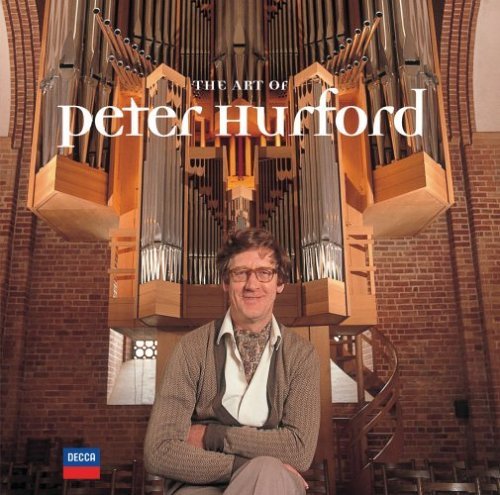

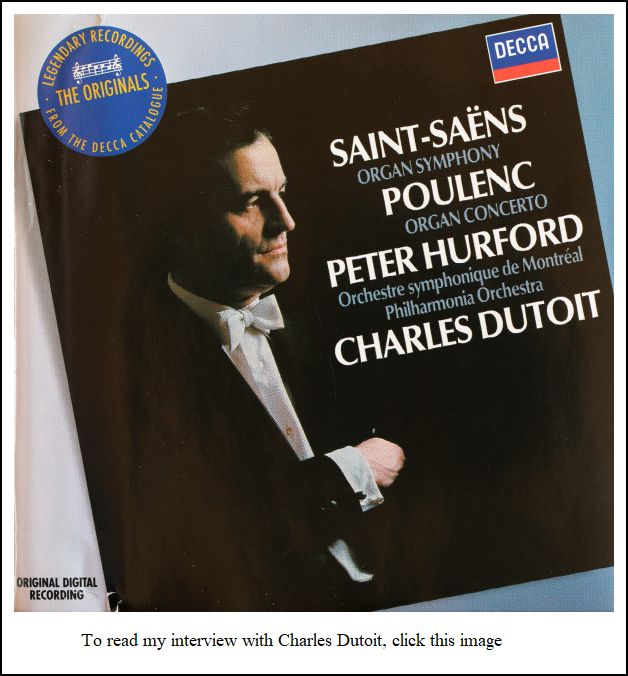 BD:
Is that better or worse to have that kind of action?
BD:
Is that better or worse to have that kind of action?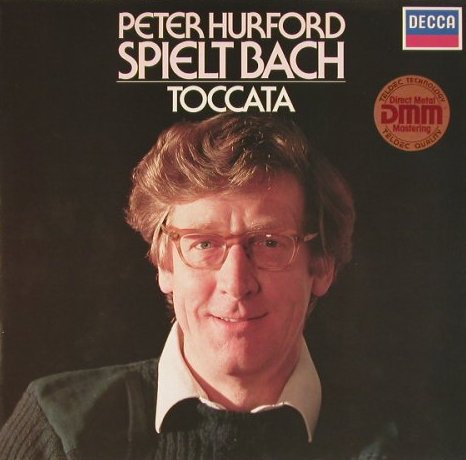
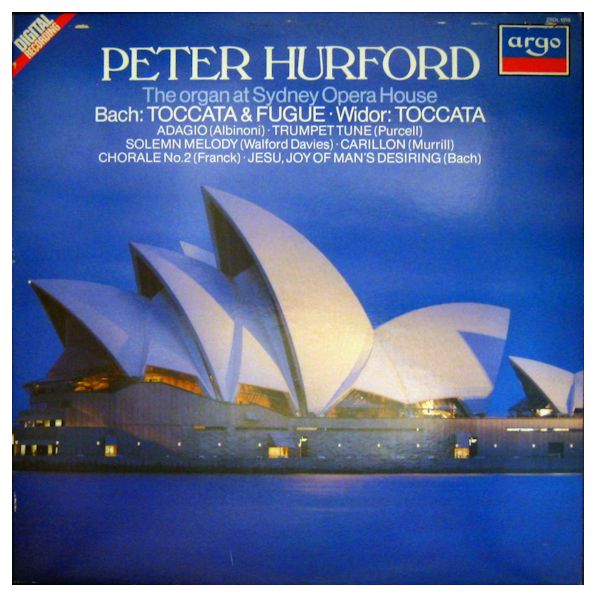 BD: Is the music not received at all by the
performer who is sending it?
BD: Is the music not received at all by the
performer who is sending it?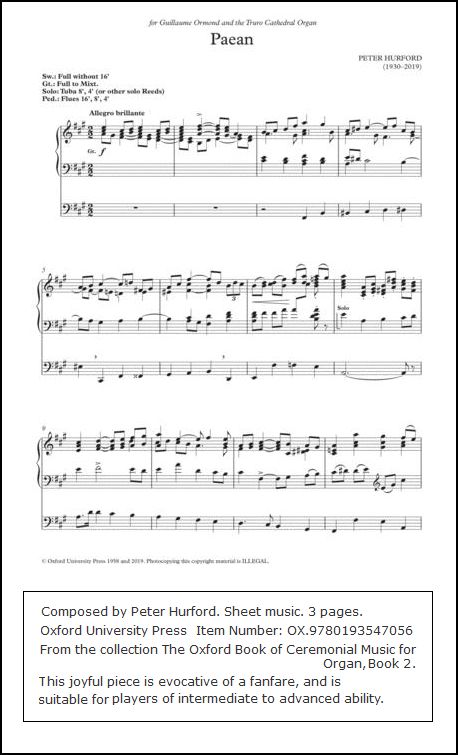 BD:
What advice do you have for younger organists coming along?
BD:
What advice do you have for younger organists coming along? 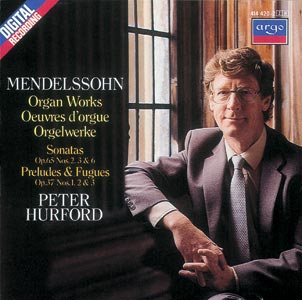 BD:
You don’t want to ask that the records be re-mastered at slightly
slower speed — without a drop in pitch? [Both
laugh] They can do that now, you know!
BD:
You don’t want to ask that the records be re-mastered at slightly
slower speed — without a drop in pitch? [Both
laugh] They can do that now, you know!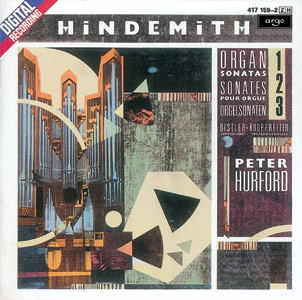 BD:
Exactly!
BD:
Exactly!|
Peter Hurford
Born: November 22, 1930 - Minehead, Somerset, England Died: March 3, 2019 - St. Albans, Hertfordshire, England The English organist (and composer), Peter Hurford, studied initially with Harold Darke, the famous and much-respected English organist and composer. He then read both music and law at Jesus College, Cambridge University, graduating with dual degrees. Through study in Paris with the blind French organist André Marchal, Hurford explored the music of the Baroque period, with a particular emphasis on J.S. Bach and the French masters, and he acquired something of his teacher's brilliance as an improviser. 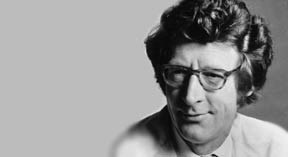 Peter Hurford's own singular notions of authentic performing style also
took form at that time and were soon regularly implemented before the public
once he had received an appointment as music master (organist and choirmaster)
at St. Albans Abbey in 1958. There, he experimented, rebuilt the organ
to comply with his convictions, and soon began to attract the attention
of other English organists unsatisfied with the traditional and often heavy-handed
Baroque style customarily heard in English churches. He conceived the idea
of an organ competition in 1963, partly to celebrate the new Harrison &
Harrison organ designed by Ralph Downes and himself. This venture was successful
mainly because of the young Hurford's rapidly growing stature in Britain
and overseas as a result of his refreshing notions of authentic performing
style. There, organists and organ scholars were able to gather to hear and
discuss performances and share scholarly findings regarding performance
style, registration, repertory, and audience building. This has grown into
the St Albans International Organ Festival, a world-renowned festival of
organ music with competitions whose past winners include many of the great
names in modern organ music including Dame Gillian Weir, David Sanger, Thomas
Trotter and Kevin Bowyer. Many a competitor counted himself fortunate to
have received an autographed copy of Hurford's recordings of Bach's complete
organ works.
Peter Hurford's own singular notions of authentic performing style also
took form at that time and were soon regularly implemented before the public
once he had received an appointment as music master (organist and choirmaster)
at St. Albans Abbey in 1958. There, he experimented, rebuilt the organ
to comply with his convictions, and soon began to attract the attention
of other English organists unsatisfied with the traditional and often heavy-handed
Baroque style customarily heard in English churches. He conceived the idea
of an organ competition in 1963, partly to celebrate the new Harrison &
Harrison organ designed by Ralph Downes and himself. This venture was successful
mainly because of the young Hurford's rapidly growing stature in Britain
and overseas as a result of his refreshing notions of authentic performing
style. There, organists and organ scholars were able to gather to hear and
discuss performances and share scholarly findings regarding performance
style, registration, repertory, and audience building. This has grown into
the St Albans International Organ Festival, a world-renowned festival of
organ music with competitions whose past winners include many of the great
names in modern organ music including Dame Gillian Weir, David Sanger, Thomas
Trotter and Kevin Bowyer. Many a competitor counted himself fortunate to
have received an autographed copy of Hurford's recordings of Bach's complete
organ works.Peter Hurford has enjoyed an enviable reputation for both his organ playing and his musical scholarship. The latter has produced not only revised ideas about performance of early music, but also different notions about the construction of the instruments upon which such music ought to be played. His extensive recordings for the Decca/London label have passed into the realm of the legendary and his live performances have attracted positive reviews, as well as stimulating numerous discussions regarding performance practice and the art of organ building. He is best known for his interpretations of Bach. His expertise is not limited to Bach, however - he is expanded to François Couperin on one side and the Romantic period on the other. His playing shows excellence in attention to stylistic detail. His playing style is noted for clean articulation, and a sense of proper tempi. His often-brisk tempi and variety of registration decidedly changed organ performance. After decades at St. Albans, Peter Hurford resigned to fulfil the demand for solo performances. By that time, his recordings had made his name a familiar one even to those who had not heard him in live performance. In addition to his concert appearances, Hurford began to devote time to teaching and made himself a welcome visiting scholar in numerous venues, especially in England and the USA. After having worked out his ideas during several decades of lecturing and performance, he assembled them in written form in his book Making Music on the Organ, published in 1988 (Oxford University Press). The simple, direct title conceals a wealth of carefully considered issues and effective solutions to them. Peter Hurford also achieved some renown as a composer of organ works and choral pieces. Mostly dating from his St. Albans years, some of them are flowingly lyrical while others are joyously animated. All reflect Hurford's skill and inclinations as an improviser. Peter Hurford's largest recording project was putting on disc the complete organ works of J.S. Bach, a project that began in the 1970's and lasted 12 years. The full set is still available along side a smaller, two-disc set of highlights. Another double-disc set of organ masses by F. Couperin is also a seminal issue. He has also made recordings of the Romantic literature for organ. |
This interview was recorded in Chicago on March 18, 1990. Portions
were used (along with recordings) on WNIB later that year, also in 1995
and 2000. The transcription was made and posted on this website in
2009.
To see a full list (with links) of interviews which have been transcribed and posted on this website, click here. To read my thoughts on editing these interviews for print, as well as a few other interesting observations, click here.
Award - winning broadcaster Bruce Duffie was with WNIB, Classical 97 in Chicago from 1975 until its final moment as a classical station in February of 2001. His interviews have also appeared in various magazines and journals since 1980, and he now continues his broadcast series on WNUR-FM, as well as on Contemporary Classical Internet Radio.
You are invited to visit his website for more information about his work, including selected transcripts of other interviews, plus a full list of his guests. He would also like to call your attention to the photos and information about his grandfather, who was a pioneer in the automotive field more than a century ago. You may also send him E-Mail with comments, questions and suggestions.